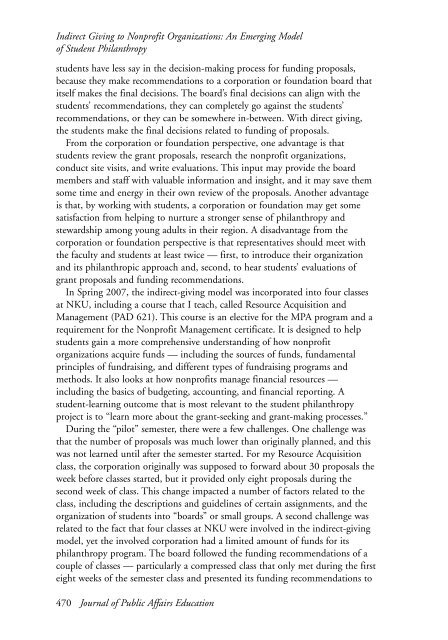JOURNAL OF PUBLIC AFFAIRS EDUCATION - National ...
JOURNAL OF PUBLIC AFFAIRS EDUCATION - National ...
JOURNAL OF PUBLIC AFFAIRS EDUCATION - National ...
Create successful ePaper yourself
Turn your PDF publications into a flip-book with our unique Google optimized e-Paper software.
Indirect Giving to Nonprofit Organizations: An Emerging Model<br />
of Student Philanthropy<br />
students have less say in the decision-making process for funding proposals,<br />
because they make recommendations to a corporation or foundation board that<br />
itself makes the final decisions. The board’s final decisions can align with the<br />
students’ recommendations, they can completely go against the students’<br />
recommendations, or they can be somewhere in-between. With direct giving,<br />
the students make the final decisions related to funding of proposals.<br />
From the corporation or foundation perspective, one advantage is that<br />
students review the grant proposals, research the nonprofit organizations,<br />
conduct site visits, and write evaluations. This input may provide the board<br />
members and staff with valuable information and insight, and it may save them<br />
some time and energy in their own review of the proposals. Another advantage<br />
is that, by working with students, a corporation or foundation may get some<br />
satisfaction from helping to nurture a stronger sense of philanthropy and<br />
stewardship among young adults in their region. A disadvantage from the<br />
corporation or foundation perspective is that representatives should meet with<br />
the faculty and students at least twice — first, to introduce their organization<br />
and its philanthropic approach and, second, to hear students’ evaluations of<br />
grant proposals and funding recommendations.<br />
In Spring 2007, the indirect-giving model was incorporated into four classes<br />
at NKU, including a course that I teach, called Resource Acquisition and<br />
Management (PAD 621). This course is an elective for the MPA program and a<br />
requirement for the Nonprofit Management certificate. It is designed to help<br />
students gain a more comprehensive understanding of how nonprofit<br />
organizations acquire funds — including the sources of funds, fundamental<br />
principles of fundraising, and different types of fundraising programs and<br />
methods. It also looks at how nonprofits manage financial resources —<br />
including the basics of budgeting, accounting, and financial reporting. A<br />
student-learning outcome that is most relevant to the student philanthropy<br />
project is to “learn more about the grant-seeking and grant-making processes.”<br />
During the “pilot” semester, there were a few challenges. One challenge was<br />
that the number of proposals was much lower than originally planned, and this<br />
was not learned until after the semester started. For my Resource Acquisition<br />
class, the corporation originally was supposed to forward about 30 proposals the<br />
week before classes started, but it provided only eight proposals during the<br />
second week of class. This change impacted a number of factors related to the<br />
class, including the descriptions and guidelines of certain assignments, and the<br />
organization of students into “boards” or small groups. A second challenge was<br />
related to the fact that four classes at NKU were involved in the indirect-giving<br />
model, yet the involved corporation had a limited amount of funds for its<br />
philanthropy program. The board followed the funding recommendations of a<br />
couple of classes — particularly a compressed class that only met during the first<br />
eight weeks of the semester class and presented its funding recommendations to<br />
470 Journal of Public Affairs Education

















